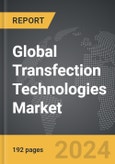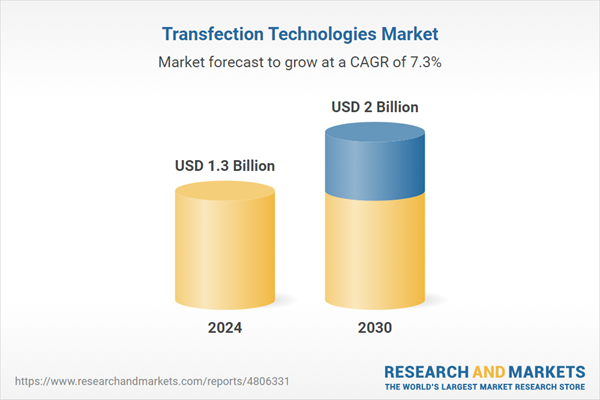The global market for Transfection Technologies was valued at US$1.3 Billion in 2024 and is projected to reach US$2.0 Billion by 2030, growing at a CAGR of 7.3% from 2024 to 2030. This comprehensive report provides an in-depth analysis of market trends, drivers, and forecasts, helping you make informed business decisions. The report includes the most recent global tariff developments and how they impact the Transfection Technologies market.
Segments: Application (Protein Production, Therapeutic Delivery, Bio-Medical Research, Other Applications).
Geographic Regions/Countries: World; United States; Canada; Japan; China; Europe (France; Germany; Italy; United Kingdom; and Rest of Europe); Asia-Pacific; Rest of World.
The analysts continuously track trade developments worldwide, drawing insights from leading global economists and over 200 industry and policy institutions, including think tanks, trade organizations, and national economic advisory bodies. This intelligence is integrated into forecasting models to provide timely, data-driven analysis of emerging risks and opportunities.
Global Transfection Technologies Market - Key Trends & Drivers Summarized
What are Transfection Technologies and Why are They Important?
Transfection Technologies encompass various methods and tools used to introduce nucleic acids into cells, enabling the study and manipulation of gene expression and function. These technologies are important for a wide range of applications in molecular biology, biotechnology, and medicine, including gene therapy, functional genomics, and drug discovery. Transfection technologies include chemical methods (such as lipid-mediated transfection), physical methods (such as electroporation and microinjection), and viral methods (using viral vectors). The importance of transfection technologies lies in their ability to facilitate precise genetic modifications, enabling researchers to investigate gene function, model diseases, and develop new therapeutic approaches.How Do Transfection Technologies Advance Scientific Research?
Transfection Technologies advance scientific research by providing efficient and versatile methods for introducing genetic material into cells. These technologies enable the study of gene expression, regulation, and function, contributing to our understanding of cellular processes and disease mechanisms. Chemical transfection methods, such as lipid nanoparticles, are widely used for their simplicity and efficiency in delivering nucleic acids to a variety of cell types. Physical methods, like electroporation, provide high transfection efficiency by using electrical pulses to permeabilize cell membranes. Viral vectors offer high efficiency and stable gene expression, making them valuable for gene therapy applications. By enabling precise genetic manipulation, transfection technologies facilitate the development of genetically modified models, the discovery of new drug targets, and the advancement of gene-based therapies.Why is the Adoption of Transfection Technologies Growing?
The adoption of Transfection Technologies is growing due to several key factors. The increasing demand for advanced research tools in genomics and biotechnology drives the need for efficient and reliable transfection methods. The rise of gene editing technologies, such as CRISPR-Cas9, requires effective transfection systems to deliver editing components into target cells. Advances in personalized medicine and the development of gene therapies necessitate robust transfection technologies to achieve precise genetic modifications. The growth of the biotechnology and pharmaceutical industries, coupled with increased investment in research and development, supports the adoption of advanced transfection technologies. Additionally, the expanding applications of transfection in drug discovery, functional genomics, and disease modeling further contribute to their widespread use in research and clinical settings.What Factors are Driving the Growth of the Transfection Technologies Market?
The growth in the Transfection Technologies market is driven by several factors. The increasing focus on genetic and genomic research creates a significant demand for advanced transfection methods to facilitate these studies. Technological advancements in transfection technologies, such as improved delivery methods and higher efficiency, enhance their performance and expand their applications. The rise of gene editing technologies, like CRISPR-Cas9, necessitates reliable transfection systems to deliver genetic material into cells, driving market growth. The emphasis on personalized medicine and the development of targeted gene therapies also propel the demand for precise transfection technologies. Additionally, the growth of the biotechnology and pharmaceutical sectors, along with increased funding for research and development, supports market expansion. The need for efficient and reproducible transfection methods in academic and industrial research further boosts the adoption of advanced transfection technologies. The development of novel treatments for genetic disorders, cancers, and other diseases underscores the importance of transfection technologies in advancing medical research and therapeutic innovation.Report Scope
The report analyzes the Transfection Technologies market, presented in terms of units. The analysis covers the key segments and geographic regions outlined below.Segments: Application (Protein Production, Therapeutic Delivery, Bio-Medical Research, Other Applications).
Geographic Regions/Countries: World; United States; Canada; Japan; China; Europe (France; Germany; Italy; United Kingdom; and Rest of Europe); Asia-Pacific; Rest of World.
Key Insights:
- Market Growth: Understand the significant growth trajectory of the Protein Production segment, which is expected to reach US$694.1 Million by 2030 with a CAGR of a 7.0%. The Therapeutic Delivery segment is also set to grow at 7.7% CAGR over the analysis period.
- Regional Analysis: Gain insights into the U.S. market, valued at $367.8 Million in 2024, and China, forecasted to grow at an impressive 6.6% CAGR to reach $313.2 Million by 2030. Discover growth trends in other key regions, including Japan, Canada, Germany, and the Asia-Pacific.
Why You Should Buy This Report:
- Detailed Market Analysis: Access a thorough analysis of the Global Transfection Technologies Market, covering all major geographic regions and market segments.
- Competitive Insights: Get an overview of the competitive landscape, including the market presence of major players across different geographies.
- Future Trends and Drivers: Understand the key trends and drivers shaping the future of the Global Transfection Technologies Market.
- Actionable Insights: Benefit from actionable insights that can help you identify new revenue opportunities and make strategic business decisions.
Key Questions Answered:
- How is the Global Transfection Technologies Market expected to evolve by 2030?
- What are the main drivers and restraints affecting the market?
- Which market segments will grow the most over the forecast period?
- How will market shares for different regions and segments change by 2030?
- Who are the leading players in the market, and what are their prospects?
Report Features:
- Comprehensive Market Data: Independent analysis of annual sales and market forecasts in US$ Million from 2024 to 2030.
- In-Depth Regional Analysis: Detailed insights into key markets, including the U.S., China, Japan, Canada, Europe, Asia-Pacific, Latin America, Middle East, and Africa.
- Company Profiles: Coverage of players such as Bio-Rad Laboratories, Inc., F. Hoffmann-La Roche AG, Life Technologies Corporation, Lonza Group AG, MilliporeSigma and more.
- Complimentary Updates: Receive free report updates for one year to keep you informed of the latest market developments.
Some of the 38 companies featured in this Transfection Technologies market report include:
- Bio-Rad Laboratories, Inc.
- F. Hoffmann-La Roche AG
- Life Technologies Corporation
- Lonza Group AG
- MilliporeSigma
- PolyPlus Battery Company (PPBC)
- Promega Corporation
- Qiagen NV
- SignaGen Laboratories
- Thermo Fisher Scientific, Inc.
Tariff Impact Analysis: Key Insights for 2025
Global tariff negotiations across 180+ countries are reshaping supply chains, costs, and competitiveness. This report reflects the latest developments as of April 2025 and incorporates forward-looking insights into the market outlook.The analysts continuously track trade developments worldwide, drawing insights from leading global economists and over 200 industry and policy institutions, including think tanks, trade organizations, and national economic advisory bodies. This intelligence is integrated into forecasting models to provide timely, data-driven analysis of emerging risks and opportunities.
What’s Included in This Edition:
- Tariff-adjusted market forecasts by region and segment
- Analysis of cost and supply chain implications by sourcing and trade exposure
- Strategic insights into geographic shifts
Buyers receive a free July 2025 update with:
- Finalized tariff impacts and new trade agreement effects
- Updated projections reflecting global sourcing and cost shifts
- Expanded country-specific coverage across the industry
Table of Contents
I. METHODOLOGYII. EXECUTIVE SUMMARY2. FOCUS ON SELECT PLAYERSIII. MARKET ANALYSISIV. COMPETITION
1. MARKET OVERVIEW
3. MARKET TRENDS & DRIVERS
4. GLOBAL MARKET PERSPECTIVE
UNITED STATES
CANADA
JAPAN
CHINA
EUROPE
FRANCE
GERMANY
ITALY
UNITED KINGDOM
REST OF EUROPE
ASIA-PACIFIC
REST OF WORLD
Companies Mentioned (Partial List)
A selection of companies mentioned in this report includes, but is not limited to:
- Bio-Rad Laboratories, Inc.
- F. Hoffmann-La Roche AG
- Life Technologies Corporation
- Lonza Group AG
- MilliporeSigma
- PolyPlus Battery Company (PPBC)
- Promega Corporation
- Qiagen NV
- SignaGen Laboratories
- Thermo Fisher Scientific, Inc.
Table Information
| Report Attribute | Details |
|---|---|
| No. of Pages | 192 |
| Published | April 2025 |
| Forecast Period | 2024 - 2030 |
| Estimated Market Value ( USD | $ 1.3 Billion |
| Forecasted Market Value ( USD | $ 2 Billion |
| Compound Annual Growth Rate | 7.3% |
| Regions Covered | Global |









